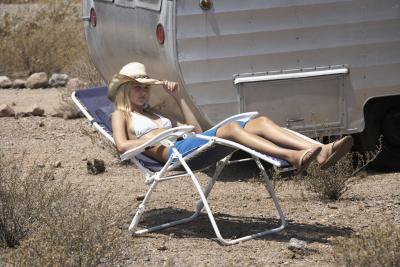
Nothing brings out the beauty in an old aluminum-clad RV like a good polishing. Oxidation—caused by the materials within the aluminum interacting with oxygen molecules—results in a whitish coating that hides the gleam of the aluminum. But what is the best way to bring back the shine on old RVs? The people "in the know" are those who maintain Airstream trailers and certain models of aircraft that came with non-painted anodized aluminum skins.
Aluminum surfaces are often covered with a clear coat to slow oxidation. Over time, the clear coat flakes away as the UV rays of the sun and time take their toll. If you begin polishing before this clear coat is fully removed, your polish job will look blotchy. Use a product like Zip Strip or Napier RemovAll to remove the clear coat, following the manufacturers' directions. Don’t use steel wool or a similar product to remove the clear coat; whatever small scratches you leave in the aluminum may still show as swirls after you've finished your polishing.
If this is the first time you've polished your RV, don't expect to complete the polishing in one step. You might need to use several grades of metal polish. The heavier grades of polish will remove any remaining clear coat and oxidation; successive grades of finer polish will bring out the shine and luster in the aluminum. One popular brand of aluminum polish, originally developed for use on aircraft, is Rolite. Another brand of polish used by many RV enthusiasts is Nuvite. Don't use any polish with ammonia in it...your aluminum will take on a brownish hue over time.
For something the size of an RV, you're going to want to use a good electric buffer. You can use the orbital polishers that are popular for waxing cars, but they may not have the power you need to cut through heavier layers of oxidation. A better choice may be an angle grinder/polisher, such as the DeWalt 849, fitted with a rubber backing pad that will hold the buffing pads. Plan to switch out the buffing pads often; once they load up with removed oxidation, the pads lose a good deal of efficiency. If you start with quality buffing pads, you can wash and dry them for re-use.
Wash the area you're going to work on, using a light detergent such as dish-washing liquid. Choose a small area, perhaps two feet by two feet. Apply several light dabs or streaks of the polish, and start passing the buffing pad over the area. Don’t bear down; let the weight of the buffer do the work. When the metal starts turning black, that’s a good sign; the black is the oxidation being removed. Wipe with a towel, and move to an adjoining area. Overlap your work areas to avoid streaking. Do a large area—perhaps one side of the RV—with the heavier grade polish before moving to a finer grade. If your RV isn't too badly oxidized, or if it has been polished within the past two to three years, you might only need to use one grade of polish. Do a final buff with a clean buffing pad, and stand back to admire your handiwork.
This is a messy job. Have plenty of soft towels available for removing the clear coat as it bubbles up, and for wiping off the oxidation during the polishing process. You can get cheap towels at a local thrift store. The grit you'll remove is difficult to wash out, so toss the towels in a trash sack as they load up with the removed material.
Have a set of work clothes that you don't expect to wear again once you're through polishing your RV. Keep a can of hand cleaner with pumice at the ready. Also, don't put the work clothes or wiping towels in your clothes washer...you'll risk getting black blotches on loads of clothes for weeks to come.